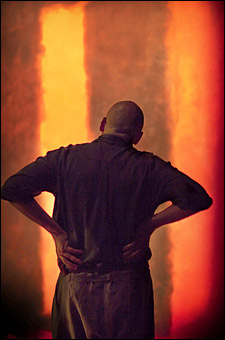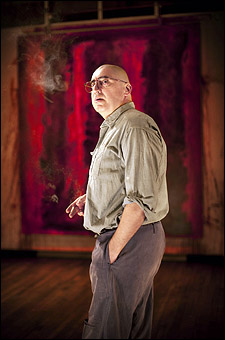
*
"I was in a sanguinary mode," John Logan allows with a laugh, recalling the writing of his first play in ten years — Red, now at the Golden — a portrait of painter Mark Rothko. The color connects the master of 20th century abstract impressionism with the demon barber of 19th century Fleet Street because it came to him while adapting Sweeney Todd for the screen, helping Tim Burton slosh the blood about.
Fact is, red colors much of Logan's career. "I've had my share of splatter over the years — 'Any Given Sunday,' 'Gladiator,' 'Last Samurai' — but I think dramatists are naturally drawn to conflict. One of the great manifestations of conflict is physical action and violence. It's been an arrow in the quiver of the playwright since Aeschylus."
The screen's first "Coriolanus" is his next blood-Red Letter Day. "Nobody has wanted to film it. Everyone hates Coriolanus. It is certainly not a Shakespeare play to make Hollywood sit up and take notice. It has never been a favorite play in the canon, nor is it the play that a lot of people really get excited about, but those who love it, love it passionately — and, thankfully, that's both Ralph Fiennes and myself."
Fiennes will direct it this spring in Serbia and play the title role opposite Gerard Butler's Tullus Aufidius, Brian Cox's Menenius and Vanessa Redgrave's Volumnia. Logan even made killings with his two earlier New York plays — 1985's Never the Sinner, about the thrill-killing of 14-year-old Bobby Franks by Richard Loeb and Nathan Leopold, and 1992's Hauptmann, about Bruno Hauptmann, who was executed for the kidnapping and murder of the Lindbergh baby. Between those Off-Broadway offerings and after, Logan has moved big-and-surefootedly through the Hollywood jungle and become a high-priced scripter who, to date, has earned two Oscar nominations (for "The Aviator" and "Gladiator") and the Writers Guild of America Award (for "RKO 281," about the making of "Citizen Kane"). On March 21, he contended for an Olivier Award for Red, which premiered in London with Alfred Molina and Eddie Redmayne. (Redmayne, playing the assistant to Molina's Rothko, took home an Olivier; Red — again with Molina and Redmayne — officially opens on Broadway April 1.)
Red catches abstract expressionist Rothko at the height of his powers, circa 1958, creating his dark red murals for the Four Seasons in the Seagram building.
 |
||
| Alfred Molina in Red. |
||
| photo by Johan Persson |
"I think biographies that try to cover an entire life are dramaturgically unsound, but to find the one instant or the one series of events in a person's life that might represent the entire life is compelling theatre. It just seemed to me the Seagram murals were so dramatic and such a landmark in his life that this was the way to explore the themes I thought were interesting, which really didn't have much to do with Mark Rothko. It had more to do with my feelings about art and theatre and mentors and fathers. Mark Rothko became the vessel for things I wanted to explore."
 |
||
| Alfred Molina in Red. |
||
| photo by Johan Persson |
Because Logan had been so deeply into the popcorn and so far away from a proscenium, he was afraid his stage technique had gotten rusty. "I had some trepidation about the muscle memory and going back into the theatre, but, once you go to that first rehearsal — and every theatre rehearsal-room the world over is exactly the same — the process is exciting, and everyone is in for the right reason. It was like riding a bike, and, happily, this bike took me from London to Broadway."
*
Next up for Logan? A new HBO series pilot called "The Miraculous Year," about a Broadway composer-lyricist. Read the recent Playbill.com story.
*
Read the earlier PlayBlog item about Alfred Molina in Red.



Matthew-Murphy.jpg)






